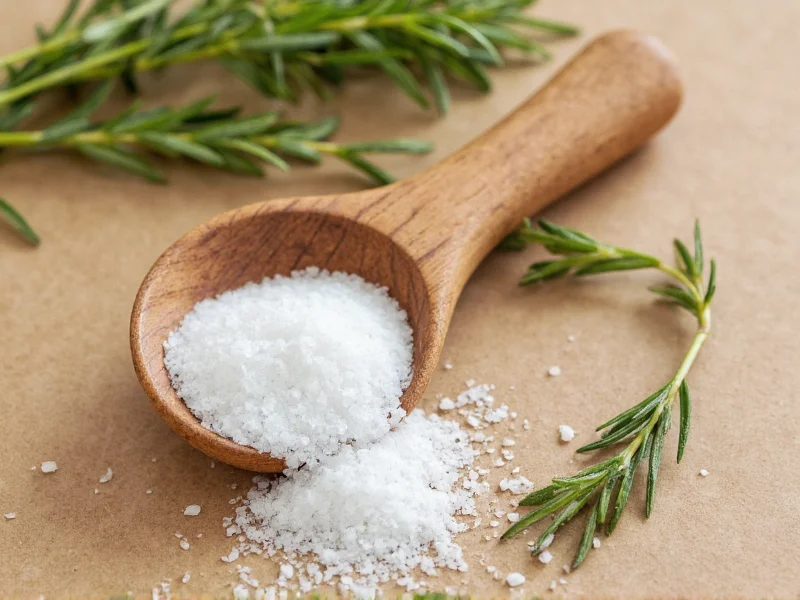Understanding the dynamic relationship between salt and thyme transforms ordinary dishes into culinary masterpieces. This classic herb-salt pairing works because sodium chloride activates taste receptors that heighten our perception of thyme's complex flavor profile, which contains thymol, carvacrol, and linalool compounds. Professional chefs leverage this synergy to create depth without overwhelming the palate.
The Science Behind Salt and Thyme Flavor Enhancement
When salt interacts with thyme, it doesn't just add咸味—it fundamentally changes how we experience the herb's flavor chemistry. Salt molecules break down thyme's cell walls during cooking, releasing more aromatic compounds into the dish. This process, called osmosis, allows thyme's essential oils to distribute more evenly throughout your recipe.
Research in food science shows that salt reduces bitterness while enhancing sweetness and umami—qualities present in thyme's complex flavor profile. The mineral composition of your salt matters: sea salt's trace minerals complement thyme's earthiness better than highly refined table salt. For optimal how to use salt and thyme together results, choose a finishing salt with larger crystals that dissolve slowly, allowing thyme's flavors to develop gradually.
Perfect Salt-to-Thyme Ratios for Different Cooking Methods
Getting the salt and thyme ratio for roasting correct separates amateur cooks from professionals. These proportions ensure balanced flavor without overpowering either ingredient:
| Cooking Method | Dried Thyme | Salt | Application Timing |
|---|---|---|---|
| Roasting meats | 1 tsp | 1 tbsp | Rub on 30 min before cooking |
| Simmering sauces | 1 tsp | 2 tsp | Add thyme first, salt in last 15 min |
| Vegetable sauté | ½ tsp | 1 tsp | Add thyme when veggies are 75% cooked |
| Bread dough | 1 tsp | 1½ tsp | Mix both into dry ingredients |
Remember that fresh thyme vs dried thyme salt ratio requires adjustment—use three times more fresh thyme than dried since drying concentrates the flavor. When working with delicate proteins like fish, reduce salt by 25% to prevent overpowering thyme's subtle notes.
Timing Techniques for Maximum Flavor Development
The sequence of adding salt and thyme dramatically impacts your dish's final flavor. For salt and thyme for chicken recipes, follow this professional technique:
- Season raw chicken with ⅓ of your salt mixture (including thyme) and refrigerate uncovered for 1-4 hours
- Before cooking, apply another ⅓ of the seasoning under the skin
- Add the final ⅓ during the last 15 minutes of cooking
This staged seasoning approach allows thyme's volatile oils to penetrate at different stages while salt works its magic on protein structure. When making stocks or soups, add thyme at the beginning to extract maximum flavor, but wait until the end to adjust salt—liquid reduction concentrates saltiness unexpectedly.
Common Salt and Thyme Mistakes to Avoid
Even experienced home cooks make these critical errors with why salt enhances thyme flavor combinations:
- Adding dried thyme too late—it needs time to rehydrate and release flavors (minimum 15 minutes in liquid)
- Using iodized table salt—the chemical aftertaste clashes with thyme's delicate floral notes
- Not accounting for salt in other ingredients—broths, cheeses, and cured meats add hidden sodium
- Crushing fresh thyme—releases bitter compounds; strip leaves gently from stems instead
Professional kitchens avoid these pitfalls by tasting at every stage and adjusting seasoning incrementally. Remember that your palate fatigues quickly—rinse with water between tastings for accurate best salt for thyme recipes adjustments.
Culinary Applications Where This Pairing Excels
Certain dishes showcase the salt and thyme ratio for roasting synergy perfectly. The herb's antiseptic properties make it ideal for fatty meats where it cuts through richness:
- Lemon-thyme roast chicken—the acid brightens both ingredients' flavors
- Garlic-thyme mashed potatoes—salt helps potatoes absorb the herb's essence
- Thyme-infused olive oil with flaky salt—perfect finishing touch for vegetables
- Herb-crusted salmon—thyme balances salt's intensity on delicate fish
For vegetarian applications, try adding thyme early when cooking beans or lentils, then finish with a sprinkle of smoked salt. The layered seasoning technique creates complexity that makes plant-based dishes satisfying without meat.
Substitutions When You're Missing an Ingredient
Understanding flavor chemistry helps when making substitutions. If you lack thyme, these alternatives work with salt:
- Oregano—use 25% less as it's more pungent than thyme
- Marjoram—sweeter profile requires slightly more salt
- Rosemary—use half the amount and add lemon zest to mimic thyme's brightness
Without salt? Try when to add thyme during cooking with these salt alternatives:
- Capers—rinse well to control sodium levels
- Miso paste—dissolve in liquid before adding thyme
- Anchovy paste—use sparingly (¼ tsp per serving) for umami depth











 浙公网安备
33010002000092号
浙公网安备
33010002000092号 浙B2-20120091-4
浙B2-20120091-4